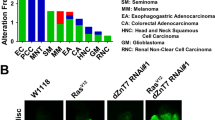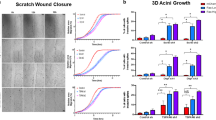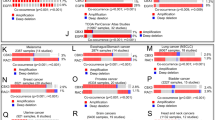Abstract
Epithelial cancer tissues often possess polyploid giant cells, which are thought to be highly oncogenic. However, the mechanisms by which polyploid giant cells are generated in tumor tissues and how such cells contribute to tumor progression remain elusive. We previously noticed in Drosophila imaginal epithelium that cells mutant for the endocytic gene rab5 exhibit enlarged nuclei. Here we find that mutations in endocytic ‘neoplastic tumor-suppressor’ genes, such as rab5, vps25, erupted, or avalanche result in generation of polyploid giant cells. Genetic analyses on rab5-defective cells reveal that cooperative activation of JNK and Yorkie generates polyploid giant cells via endoreplication. Mechanistically, Yorkie-mediated upregulation of Diap1 cooperates with JNK to downregulate the G2/M cyclin CycB, thereby inducing endoreplication. Interestingly, malignant tumors induced by Ras activation and cell polarity defect also consist of polyploid giant cells, which are generated by JNK and Yorkie-mediated downregulation of CycB. Strikingly, elimination of polyploid giant cells from such malignant tumors by blocking endoreplication strongly suppressed tumor growth and metastatic behavior. Our observations suggest that JNK and Yorkie, two oncogenic proteins activated in many types of human cancers, cooperatively drive tumor progression by generating oncogenic polyploid giant cells.
This is a preview of subscription content, access via your institution
Access options
Subscribe to this journal
Receive 50 print issues and online access
$259.00 per year
only $5.18 per issue
Buy this article
- Purchase on Springer Link
- Instant access to full article PDF
Prices may be subject to local taxes which are calculated during checkout






Similar content being viewed by others
References
Davoli T, Lange TD. The causes and consequences of polyploidy in normal development and cancer. Annu Rev Cell Biol. 2011;27:585–610.
Fox DT, Duronio RJ. Endoreplication and polyploidy: insights into development and disease. Development. 2013;140:3–12.
Zhang S, Mercado-Uribe I, Xing Z, Sun B, Kuang J, Liu J. Generation of cancer stem-like cells through the formation of polyploid giant cancer cells. Oncogene. 2014;33:116–28.
Hariharan IK, Bilder D. Regulation of imaginal disc growth by tumor-suppressor genes in. Drosoph Annu Rev Genet. 2006;40:335–61.
Zerial M, McBride H. Rab proteins as membrane organizers. Nat Rev Mol Cell Biol. 2001;2:107–17.
Takino K, Ohsawa S, Igaki T. Loss of Rab5 drives non-autonomous cell proliferation through TNF and Ras signaling. Drosoph Dev Biol.2014;395:19–28.
Uhlirova M, Bohmann D. JNK- and Fos-regulated Mmp1 expression cooperates with Ras to induce invasive tumors in Drosophila. EMBO J. 2006;25:5294–304.
Herz HM, Chen Z, Scherr H, Lackey M, Bolduc C, Bergmann A. vps25 mosaics display non-autonomous cell survival and overgrowth, and autonomous apoptosis. Development. 2006;133:1871–80.
Robinson BS, Moberg KH. Drosophila endocytic neoplastic tumor suppressor genes regulate Sav/Wts/Hpo signaling and the c-Jun N-terminal kinase pathway. Cell Cycle. 2011;10:4110–8.
Glise B, Bourhon H, Noselli S. Hemipterous encodes a novel Drosophila MAP kinase kinase, required for epithelial cell sheet movement. Cell. 1995;83:451–61.
Gutierrez GJ, Tsuji T, Cross JV, Davis RJ, Templeton DJ, Jiang W, et al. JNK-mediated phosphorylation of Cdc25C regulates cell cycle entry and G(2)/M DNA damage checkpoint. J Biol Chem. 2010;285:14217–28.
Lindqvist A. Cyclin B-Cdk1 activates its own pump to get into the nucleus. J Cell Biol. 2010;198:197–9.
Huang J, Wu S, Barrera J, Matthews K, Pan D. The Hippo signaling pathway coordinately regulates cell proliferation and apoptosis by inactivating Yorkie, the Drosophila Homolog of YAP. Cell. 2005;122:421–34.
Goyal L, McCall K, Agapite J, Hartwieg E, Steller H. Induction of apoptosis by Drosophila reaper, hid and grim through inhibition of IAP function. EMBO J. 2000;19:589–97.
Brumby AM, Richardson HE. scribble mutants cooperate with oncogenic Ras or Notch to cause neoplastic overgrowth in Drosophila. EMBO J. 2003;22:5769–79.
Pagliarini RA, Xu T. A genetic screen in Drosophila for metastatic behavior. Science. 2003;302:1227–31.
Igaki T, Pagliarini RA, Xu T. Loss of cell polarity drives tumor growth and invasion through JNK activation in. Drosoph Curr Biol. 2006;16:1139–46.
Ohsawa S, Sato Y, Enomoto M, Nakamura M, Betsumiya A, Igaki T. Mitochondrial defect drives non-autonomous tumour progression through Hippo signalling in Drosophila. Nature. 2012;490:547–51.
Doggett K, Grusche FA, Richardson HE, Brumby AM. Loss of the Drosophila cell polarity regulator Scribbled promotes epithelial tissue overgrowth and cooperation with oncogenic Ras-Raf through impaired Hippo pathway signaling. BMC Dev Biol. 2011;11:57.
Sabapathy K, Hochedlinger K, Nam SY, Bauer A, Karin M, Wagner EF. Distinct roles for JNK1 and JNK2 in regulating JNK activity and c-Jun-dependent cell proliferation. Mol Cell. 2004;15:713–25.
Nakamura M, Ohsawa S, Igaki T. Mitochondrial defects trigger proliferation of neighbouring cells via a senescence-associated secretory phenotype in Drosophila. Nat Commun. 2014;5:5264.
Gong FR, Wu MY, Shen M, Zhi QM, Xu ZK, Wang R, et al. PP2A inhibitors arrest G2/M transition through JNK/Sp1-dependent down-regulation of CDK1 and autophagy-dependent up-regulation of p21. Oncotarget. 2015;6:18469–83.
Wang H, Zhang T, Sun W, Wang Z, Zuo D, Zhou Z, et al. Erianin induces G2/M-phase arrest, apoptosis, and autophagy via the ROS/JNK signaling pathway in human osteosarcoma cells in vitro and in vivo. Cell Death Dis. 2016;7:e2247.
Shabbeer S, Omer D, Berneman D, Weitzman O, Alpaugh A, Pietraszkiewicz A, et al. BRCA1 targets G2/M cell cycle proteins for ubiquitination and proteasomal degradation. Oncogene. 2013;32:5005–16.
Xu D, Woodfield SE, Lee TV, Fan Y, Antonio C, Bergmann A. Genetic control of programmed cell death (apoptosis) in Drosophila. Fly. 2009;3:78–90.
Hershko A. Mechanisms and regulation of the degradation of cyclin B. Philos Trans R Soc Lond B Biol Sci. 1999;354:1571–5.
Mohd-Sarip A, Lagarou A, Doyen CM, van der Knaap JA, Aslan Ü, Bezstarosti K, et al. Transcription-independent function of Polycomb group protein PSC in cell cycle control. Science. 2012;336:744–4.
Moberg KH, Schelble S, Burdick SK, Hariharan IK. Mutations in erupted, the Drosophila ortholog of mammalian tumor susceptibility gene 101, elicit non-cell-autonomous overgrowth. Dev Cell. 2005;9:699–710.
Giebel B, Wodarz A. Tumor suppressors: control of signaling by endocytosis. Curr Biol. 2006;16:R91–2.
Frierson HF Jr.. Ploidy analysis and S-phase fraction determination by flow cytometry of invasive adenocarcinomas of the breast. Am J Surg Pathol. 1991;15:358–67.
Davidson B, Konstantinovsky S, Kleinberg L, Nquyen MT, Bassarova A, Kvalheim G, et al. The mitogen-activated protein kinases (MAPK) p38 and JNK are markers of tumor progression in breast carcinoma. Gynecol Oncol. 2006;102:453–61.
Maugeri-Saccà M, Barba M, Pizzuti L, Vici P, Di Lauro L, Dattilo R, et al. The Hippo transducers TAZ and YAP in breast cancer: oncogenic activities and clinical implications. Expert Rev Mol Med. 2015;17:e14.
Zhang S, Chen Q, Liu Q, Li Y, Sun X, Hong L, et al. Hippo signaling suppresses cell ploidy and tumorigenesis through Skp2. Cancer Cell. 2017;31:669–84.
Xu T, Rubin GM. Analysis of genetic mosaics in developing and adult Drosophila tissues. Development. 1993;117:1223–37.
Lee T, Luo L. Mosaic analysis with a repressible cell marker for studies of gene function in neuronal morphogenesis. Neuron. 1999;22:451–61.
Acknowledgements
We thank Masato Enomoto, Yukari Sando, Yuya Sanaki, Kiichiro Taniguchi, and Masatoshi Yamamoto for discussions, and K. Sawada, K. Baba and Y. Senda for technical assistance. We also thank Leonie Quinn, Masayuki Miura, Takashi Adachi-Yamada, the Bloomington Stock Center, the Drosophila Genomics and Genetic Resources (DGGR), and the FlyORF for fly stocks. This work was supported in part by grants from the MEXT/JSPS KAKENHI (Grant Number 26114002, 16K14606, 16H02505, 15H05862, 26711013, and 17H03673) to S.O. and T.I., the Naito Foundation to T.I., the Takeda Science Foundation to S.O. and T.I., the Japan Foundation for Applied Enzymology to S.O., and Japan Agency for Medical Research and Development (Project for Elucidating and Controlling Mechanisms of Aging and Longevity) to T.I. B.C. was supported in part by Ichikawa International Scholarship Foundation.
This work was supported in part by grants from the MEXT/JSPS KAKENHI (Grant Numbers 26114002, 16K14606, 16H02505, 15H05862, 26711013, and 17H03673), the Naito Foundation, the Takeda Science Foundation, the Japan Foundation for Applied Enzymology, and Japan Agency for Medical Research and Development (Project for Elucidating and Controlling Mechanisms of Aging and Longevity) to T.I. B.C. was supported in part by Ichikawa International Scholarship Foundation.
Author information
Authors and Affiliations
Corresponding author
Ethics declarations
Conflict of interest
The authors declare that they have no conflict of interest.
Electronic supplementary material
Rights and permissions
About this article
Cite this article
Cong, B., Ohsawa, S. & Igaki, T. JNK and Yorkie drive tumor progression by generating polyploid giant cells in Drosophila. Oncogene 37, 3088–3097 (2018). https://doi.org/10.1038/s41388-018-0201-8
Received:
Revised:
Accepted:
Published:
Issue Date:
DOI: https://doi.org/10.1038/s41388-018-0201-8
This article is cited by
-
A novel regulator of ER Ca2+ drives Hippo-mediated tumorigenesis
Oncogene (2020)



